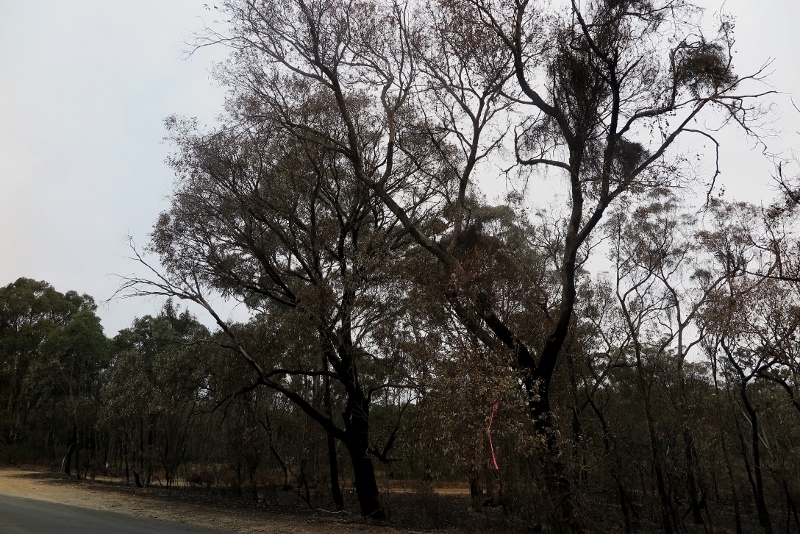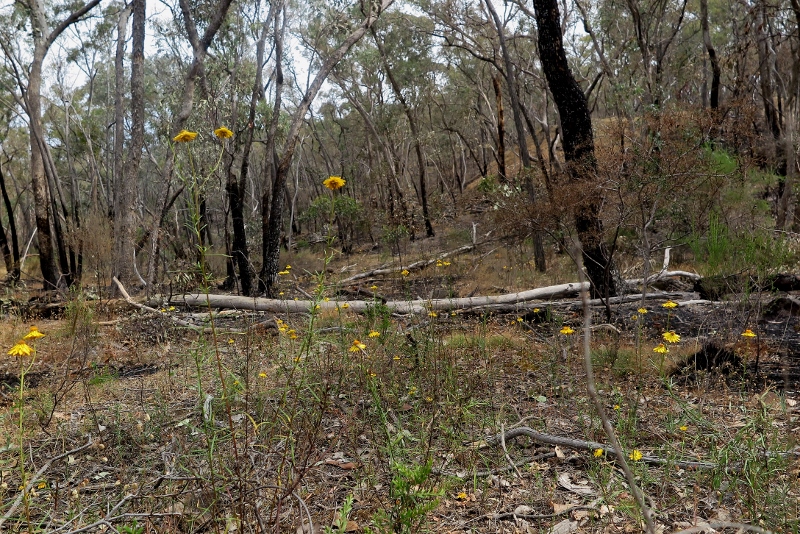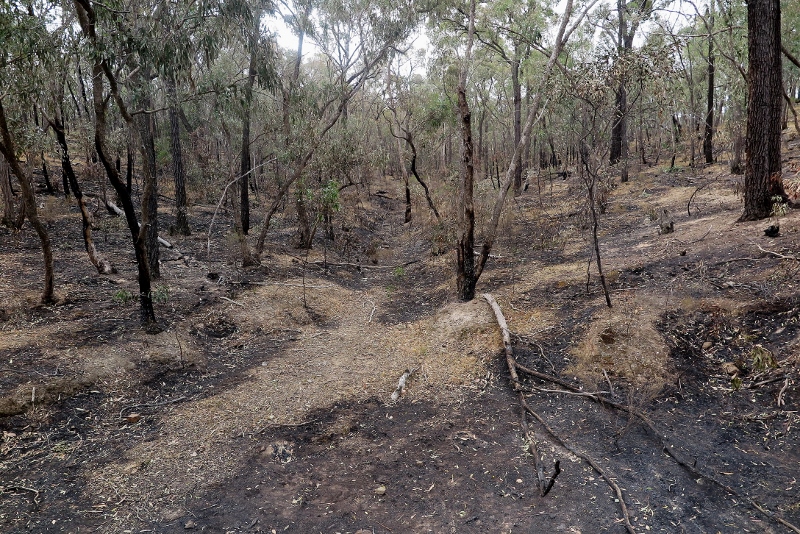DELWP conducted a fuel reduction burn in the area south of Jacobs track, along the Vaughan Chewton road in the week beginning November 18. The fire was lit on the 18th before the dire weather forecast for the following Thursday was issued. As it happened, the burn passed without incident, though nearby residents were understandably concerned at the decision to light a fire so close to a day of forecast high temperatures and vicious winds. The fire did flare up in spots, but was controlled, and as of November 26 was still being patrolled.
This was a 95 hectare burn, originally planned for last Autumn. It was a ‘Bushfire moderation zone [BMZ]’ burn, aimed at reducing 80 per cent of the fuel in the designated area. The burn is designed to provide some protection for Fryerstown from fire coming from its north. BMZ burns are directed at protecting human assets, and ecological considerations are not central to them.
The result, as with most of these exercises, was mixed: not as bad as it could have been, not as good as it should be. As an illustration: DELWP policy aims to clean up ground fuel and some scrub, and to avoid bringing down big trees in management burns, but we haven’t seen one which has pulled off this feat. Department policy tries to explain this deficiency with statements like, ‘Occasionally an unhealthy tree may die after a fire or planned burn’, something we’re a bit sceptical about. In the current case, the aim to protect big trees (very rare in this patch of bush) was largely achieved, with one bizarre exception: right on the road, at the edge of the fire, where you would have thought it would be very visible to patrols, perhaps the biggest eucalypt in the zone has been scorched to the crown. This was not an unhealthy tree, but the prognosis for its survival through the summer is not great.

Scorched trees on the Chewton Fryerstown road: in theory large trees should not be damaged in reduction burns.
A question hovering over all these exercises should never be forgotten: what is their effect, ecologically? Fire managers are in an unenviable position. Any bushfire outbreak exposes them to a relentless media campaign accusing them of not doing enough burning. The ecological effects of management fire are quieter, more complex and more long term. Managers’ challenge is to achieve human safety without destroying the natural environment which keeps us alive. Are they well enough resourced to do this? We’ve frequently expressed our doubts about this one.

In the fire zone, Spring Gully: Bushfire Management Zones are not directly concerned with ecological values, but surviving patches like this are important in forest health.





 Click on image for info/order page
Click on image for info/order page Click on image for info/order page
Click on image for info/order page Click on image for info/order page
Click on image for info/order page





















Every cloud has a silver lining. The more devestating the fires become, the more people will feel the urge to do something about climate change. We ozies are a complacent lot: droughts, floods, cyclones, no worries, but bushfires? Bushfires scare the living daylights out of us, and so they should.
The first comandment of the Xtinction Rebellion Gospel is:
Tell the Truth about Climate Change, so l have gone to a lot of trouble to distill the vast amount of data on the subject into a few pithy paragraphs:
https://binsblog.org/
As a resident of spring gully the planned burn was very stressful to the whole community and we were very lucky that it did not go pear shaped. This planned burn I feel is an example of DELWP being forced to burn in the few days available to them. An article by Dr Andrew Bennett stated that there are on average only 10 days per year where planned burns can occur. Did this force DELWP’s hand to burn on Monday when the forecast was for hot and high winds the following thursday? Or was it to achieve targets which they still have?
My question is why did this planned burn happen? What is the reporting requirements for a near miss? What did DELWP learn from the Lancefield fires they started in 2015 (https://www.abc.net.au/news/2015-11-19/lancefield-fire-poorly-planned-under-staffed-report-finds/6952528)?
When we called on Monday to express our concerns about lighting this fire, DELWP said they would have the fire out by Tuesday. DELWP’s local fire manager said their forecast that they use was not that bad for the thursday. We were all pretty concerned and many people evacuated as the fire was not out by Tuesday and in fact took some time to put out (and after Lancefield and a number of other fires caused by DELWP we were not taking any chances).
Not only was a fire hazard created but three units and one bulldozer we were told would not be leaving the area and be monitoring it continually putting fires out night and day, these units would not be available to any other fires that may have happened. Thereby increasing the risk to others in need in the area.
My wish is that there was more science to support the effectiveness of planned burns in reducing wildfire risk, as every scientific study I have read says otherwise. I appreciate that some planned burns are not to reduce fuel but to prevent spotting etc in other areas or so they can reduce the spread of wildfires. I would like to see more strategies to protect local communities who live in high risk zones like community fire shelters, bushfire awareness training etc that will upskill communities to expect a wildfire at some point rather than hope planned burns work at reducing spread of a wildfire. Too many eggs in one basket.
Either way rigorous science and adapting the fire strategies to the very different vegetation communities ie Box Ironbark versus Tall Wet Forest should be a critical component. Sadly I do not believe from what I have read that this is happening. Every strategy needs adaptive management based on good data. Rather than appealing to people demanding for more planned burns based solely on what they have read by Andrew Bolt etc . Lets look at facts and results and adapt.